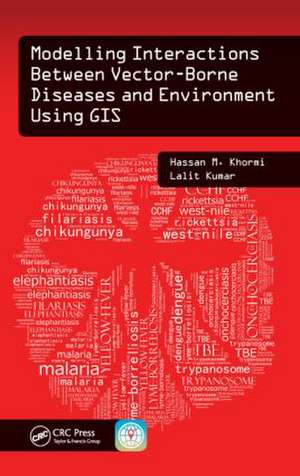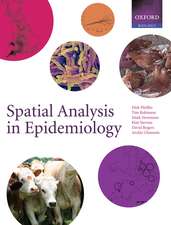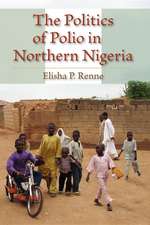Modelling Interactions Between Vector-Borne Diseases and Environment Using GIS
Autor Hassan M. Khormi, Lalit Kumaren Limba Engleză Hardback – mai 2015
Infections transmitted by mosquitoes, ticks, triatomine bugs, sandflies, and black flies cause significant rates of death and disease, especially in developing countries. Why are certain places more susceptible to vector-borne diseases? Modelling Interactions Between Vector-Borne Diseases and Environment Using GIS reveals how using geographic information systems (GISs) can provide a greater understanding of how vector-borne diseases are spread and explores the use of geographical techniques in vector-borne disease monitoring, management, and control. This text provides readers with a better understanding of the vector-borne disease problem and its impact on public health.
Introduces New Spatial Approaches Based on Location and Environment
The book exposes readers to information on how to identify vector hotspots, determine when and where they can occur, and eliminate vector breeding sites. Utilizing simple illustrations based on real data, as well as the authors’ more than 20 years of experience in the field, this text combines key spatial analysis techniques available in modern GIS with real-world applications. It offers step-by-step instruction on developing vector-borne disease risk models at different spatial and temporal scales and helps practitioners formulate disease causation hypotheses and identify areas at risk. In addition, it addresses medical geography, GIS, spatial analysis, and modelling, and covers other factors related to the spread of vector-borne diseases.
This book:
- Gives an overview of common vector-borne diseases, GIS-based mapping and modelling, impacts of climate change on vector distributions, and availability and importance of accurate epidemiologically relevant spatial data
- Describes modelling and simulating the prevalence of vector-borne diseases around the world
- Summarizes some key spatial techniques and how they can be used to aid in the analysis of geographical and attributed data
- Defines the concept of establishing and characterizing spatial data systems, including their quality, errors, references, and issues of scale, and building such a system from often quite separate, disparate sources
- Shows how to develop weather-based predictive modelling, which can be used to predict the weekly trend of vector abundance
- Provides a GIS case study for modelling the future potential distribution of vector-borne disease based on different climatic change scenarios
| Toate formatele și edițiile | Preț | Express |
|---|---|---|
| Paperback (1) | 537.11 lei 6-8 săpt. | |
| CRC Press – 31 mar 2021 | 537.11 lei 6-8 săpt. | |
| Hardback (1) | 876.79 lei 6-8 săpt. | |
| CRC Press – mai 2015 | 876.79 lei 6-8 săpt. |
Preț: 876.79 lei
Preț vechi: 1254.26 lei
-30% Nou
Puncte Express: 1315
Preț estimativ în valută:
167.79€ • 182.20$ • 140.95£
167.79€ • 182.20$ • 140.95£
Carte tipărită la comandă
Livrare economică 22 aprilie-06 mai
Preluare comenzi: 021 569.72.76
Specificații
ISBN-13: 9781482227383
ISBN-10: 148222738X
Pagini: 262
Ilustrații: 65 black & white illustrations, 6 black & white tables
Dimensiuni: 156 x 234 x 20 mm
Greutate: 0.52 kg
Ediția:1
Editura: CRC Press
Colecția CRC Press
ISBN-10: 148222738X
Pagini: 262
Ilustrații: 65 black & white illustrations, 6 black & white tables
Dimensiuni: 156 x 234 x 20 mm
Greutate: 0.52 kg
Ediția:1
Editura: CRC Press
Colecția CRC Press
Cuprins
Introduction. Modelling and Simulating the Prevalence of Vector-Borne Diseases Around the World and Efforts for Combat and Control. Cartographies and Maps of Vector-Borne Diseases. Spatial Data. Common Spatial Methods for Modelling and Analyzing Spatial and Temporal Patterns and Distributions of Mosquito-Borne Diseases. Spatial Variation Risk. Modelling Associations between Mosquito-Borne Diseases and Environmental and Socioeconomic Factors. Global Climate Change and Modelling the Potential Distribution of Vector-Borne Disease. Conclusion.
Notă biografică
Dr. Hassan M. Khormi is an assistant professor in the Department of Geography, Umm Al-Qura University (UQU), where he teaches geographic information systems (GISs) and remote sensing. Also, Dr. Hassan is a Vice Dean of the Institute of Consulting Research and Studies. In early 2013, he accepted his position as assistant professor in the Department of Geography and as deputy director of the GIS Technology Innovation Centre for administrative affairs. He is also a consultant (part-time) at Jeddah Municipality and an adjunct lecturer in the School of Environment and Rural Science, University of New England, Australia. His main research interests are in the fields of environmental modelling and GIS applications on vector-borne diseases.
Dr. Lalit Kumar is an associate professor of spatial information technologies at the University of New England in Australia. He comes from Fiji, where he undertook his undergraduate and postgraduate studies in environmental science. Dr Kumar’s expertise is in the use of GISs and remote-sensing technologies for mapping and modelling the environment, particularly natural resources and agricultural systems. In addition, he has contributed to over 150 publications, with over 100 journal articles in international peer-reviewed journals. Dr. Kumar is also an associate editor for the journal ISPRS Journal of Photogrammetry and Remote Sensing and an academic editor for PLoS ONE.
Dr. Lalit Kumar is an associate professor of spatial information technologies at the University of New England in Australia. He comes from Fiji, where he undertook his undergraduate and postgraduate studies in environmental science. Dr Kumar’s expertise is in the use of GISs and remote-sensing technologies for mapping and modelling the environment, particularly natural resources and agricultural systems. In addition, he has contributed to over 150 publications, with over 100 journal articles in international peer-reviewed journals. Dr. Kumar is also an associate editor for the journal ISPRS Journal of Photogrammetry and Remote Sensing and an academic editor for PLoS ONE.
Recenzii
"… really a good book. … adds new information and experiences to the fields of medical geography, environmental impacts, and GIS analysis as a decision support system.
—Gomaa Mohamed Dawod, Survey Research Institute, Giza, Egypt
"… presented in a logical, simple to understand manner. Practical examples that are conxtualised to GIS techniques were used, making the story line relevant and ready to use by decision makers."
—Prof Onisimo Mutanga, University of KwaZulu Natal
—Gomaa Mohamed Dawod, Survey Research Institute, Giza, Egypt
"… presented in a logical, simple to understand manner. Practical examples that are conxtualised to GIS techniques were used, making the story line relevant and ready to use by decision makers."
—Prof Onisimo Mutanga, University of KwaZulu Natal
Descriere
This timely and groundbreaking work demonstrates how to develop models of vector-borne disease risks based on different environmental and socioeconomic variables and to assess the association between these variables and their vectors in a geographic information system (GIS) environment. It addresses new spatial approaches and techniques based on location and environment. The book also introduces methods to identify, determine, and analyze the trend, movement, and distribution of diseases and the vectors that transmit disease.




















